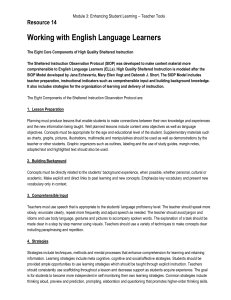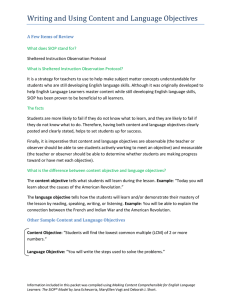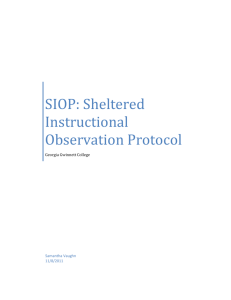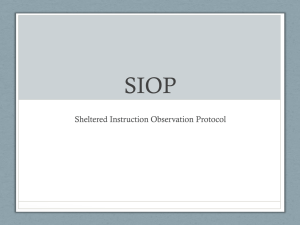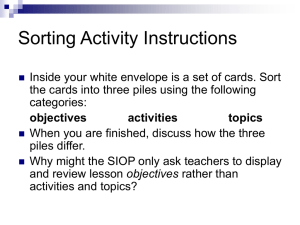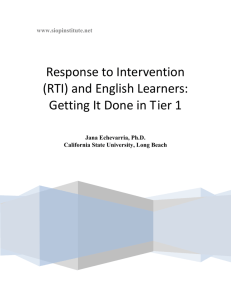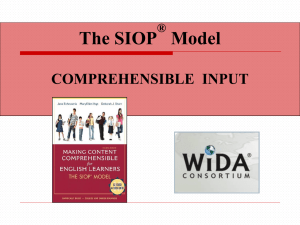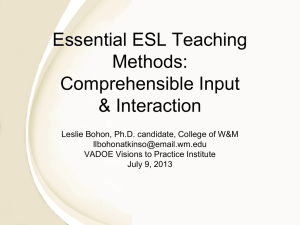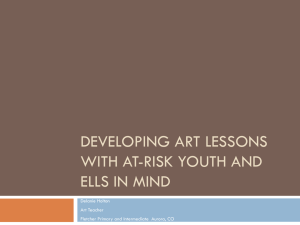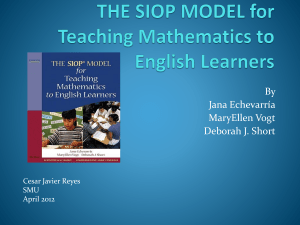Language Objectives - Curriculum and Instruction
advertisement
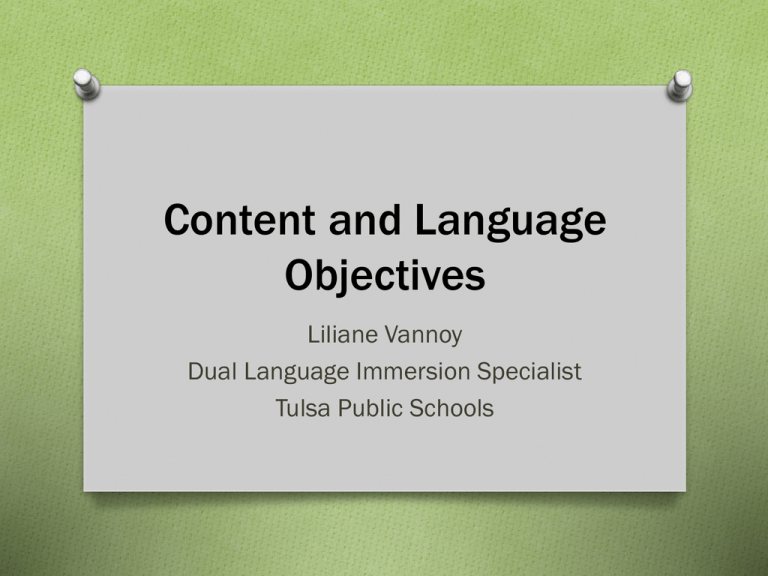
Content and Language Objectives Liliane Vannoy Dual Language Immersion Specialist Tulsa Public Schools Objective O The presentation will focus on resources and strategies to help educators develop content and language objectives. Sheltered Instruction Activity : Can you share the definition of Sheltered Instruction ? Sheltered Instruction Definition O Ways of making content understandable for English learners while they are acquiring English proficiency. Sheltered Instruction Activity : As a group, can you name all the parts that should be involved in delivering sheltered instruction ? There are 8 parts. Sheltered Instruction O Lesson Preparation O Building Background O Comprehensible Input O Strategies O Interaction O Practice and Application O Lesson Delivery O Review and Assessment Content and Language Objective Lesson Preparation Sources of Content Objectives O School district O State content standards O Teacher’s guide O Common Core Echevarria & Graves (2007) Content objectives O What students will learn or do O Be stated simply orally and in writing O Tied to specific grade level content standard Activity O Write a content objective that is common for your subject area or grade level. Content Objectives O Simple phrasing O Key words O Illustrations Content and Language Objectives O Cleary defined O Displayed O Reviewed with students Echevarria, Vogt, and Short (2010) Making Content Comprehensible for English Learners: The SIOP ® Model Activity O How do you present your content objectives to your students? O Where do you post your objectives? O How do you post your objectives? Krashen O All learning is second language. O All content areas have their specific language with specific academic vocabulary. Language Objectives O Remember that obtaining a second language is a process. O Language objectives may cover a range from process-oriented to performance-oriented statements. Echevarria, Vogt, and Short (2010) Making Content Comprehensible for English Learners: The SIOP ® Model Process to Performance Process Performance •Explore •Listen •Recognize •Draft •Write •Give an oral presentation •Edit Discuss in small groups Progression of Language O Recognize metaphors in the text O Discuss the functions of metaphors O Write three metaphors O Write a paragraph that describes a setting using metaphors Echevarria, Vogt, and Short (2010) Making Content Comprehensible for English Learners: The SIOP ® Model Remember O You should plan for a variety of language objectives based on students proficiency levels. O Your classroom will have a variety of WIDA scores. Receptive and Productive Language Skills Receptive Skills Productive Skills O Listening O Speaking O Reading O Writing Echevarria, Vogt, and Short (2010) Making Content Comprehensible for English Learners: The SIOP ® Model Summary Process Receptive Skills Listening Reading Performance Productive Skills Speaking Writing Content Objective Activity: O Read this objective: Students will investigate and understand the basic needs and life processes of plants and animals. O Rewrite in a simpler format : O Rewrite it for a proficiency level 3 or 4 O Rewrite it for a proficiency level 1 or 2 . Content Objective for level 3 and 4 O Students will investigate and understand the basic needs and life processes of plants and animals. O Students will identify parts of a tree and their functions. Content Objective for level 1 or 2 O Students will investigate and understand the basic needs and life processes of plants and animals. O Identify parts of a tree. O “ Today you will learn about parts of a tree and you will be able to identify the parts.” Content Objective Progression O Students will investigate and understand the basic needs and life processes of plants and animals. O Students will identify parts of a tree and their functions. O Identify parts of a tree. O “ Today you will learn about parts of a tree and you will be able to identify the parts.” Categories for Developing Language Objectives O Key vocabulary O Language Functions O Language Skills O Grammar or Language Structure O Lesson Tasks O Language Learning Strategies Echevarria, Vogt, and Short (2010) Making Content Comprehensible for English Learners: The SIOP ® Model Clock Activity O Walk around and set an appointment with O O O O one person at each time. You and your partner will discuss the categories for developing language objectives. Before you begin, shake hands, introduce yourself and make eye contact. Thank your partner for their help. Walk quietly to your next appointment. Clock Activity O You and your partner will discuss the categories for developing language objectives. O At 12:00 discuss categories 1-2 O At 3:00 discuss categories 3-4 O At 6:00 discuss categories 5-6 Key Vocabulary O It refers to the technical terms, concept words, and other words needed for the activities related to the lesson. O Students will be able to define the terms geometric figure and congruent orally and in writing. Echevarria, Vogt, and Short (2010) Making Content Comprehensible for English Learners: The SIOP ® Model Language Functions O It refers to the ways students use language in the lesson. O Students will be able to compare geometric figures and describe characteristics that are similar or different. Echevarria, Vogt, and Short (2010) Making Content Comprehensible for English Learners: The SIOP ® Model Language Skills O They refer to listening, reading, writing and speaking skills that students need to learn. O Students will be able to listen to teacher descriptions in order to draw different types of parallelograms. Echevarria, Vogt, and Short (2010) Making Content Comprehensible for English Learners: The SIOP ® Model Grammar or language Structures O It refers to questioning patterns, past or future tense verbs, paragraph writing, pronoun usage, sentence formation and structure clues for words like roots, prefixes, and suffixes. Students will be able to use comparative phrases such as greater than, smaller than, less than and equal to orally and in writing when describing geometric figures and angles. Echevarria, Vogt, and Short (2010) Making Content Comprehensible for English Learners: The SIOP ® Model Lesson task O It refers to the language embedded in the lesson assignment. O Students will be able to record real-life examples of three dimensional figures and describe their uses. Example: a soccer ball is a sphere Echevarria, Vogt, and Short (2010) Making Content Comprehensible for English Learners: The SIOP ® Model Language Learning Strategies O It refers to corrective strategies, self monitoring strategies, prereading strategies, or language practice strategies, O Students will be able to represent data in a bar graph. Echevarria, Vogt, and Short (2010) Making Content Comprehensible for English Learners: The SIOP ® Model Content and Language Objectives Verbs for Content Objectives O O O O O O O O Identify Solve Investigate Distinguish Hypothesize Create Select Draw conclusions O O O O O O O O O Verbs for Language Objectives Listen for Retell Define Find the main idea Compare Summarize Rehearse Persuade Write Check List Echevarria, Vogt, and Short (2010) Making Content Comprehensible for English Learners: The SIOP ® Model O The objectives are observable O The objectives are written in a language the O O O O students can understand The content is related to the lesson Language objectives promotes academic language growth Language objective connects with lesson topic There is an assessment to check if students met the objectives Resources O WIDA “ Can do” descriptors O National Standards developed by TESOL (Teachers of English to Speakers of Other Language) O Common Core Standards O Echevarria, Vogt, and Short (2010) Making Content Comprehensible for English Learners: The SIOP ® Model (PEARSON) O vannoli@tulsaschools.org
